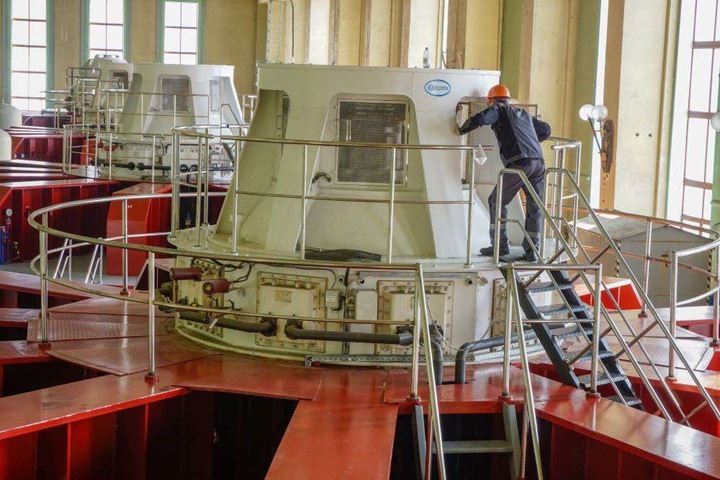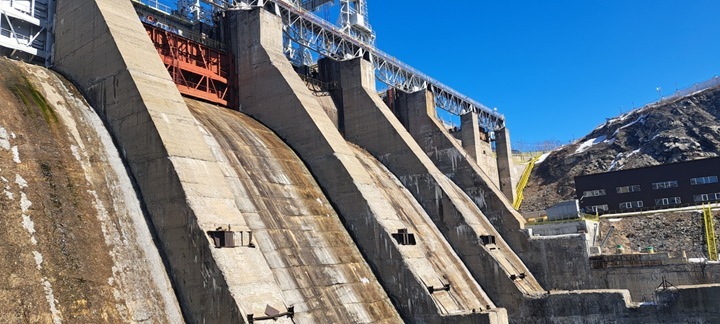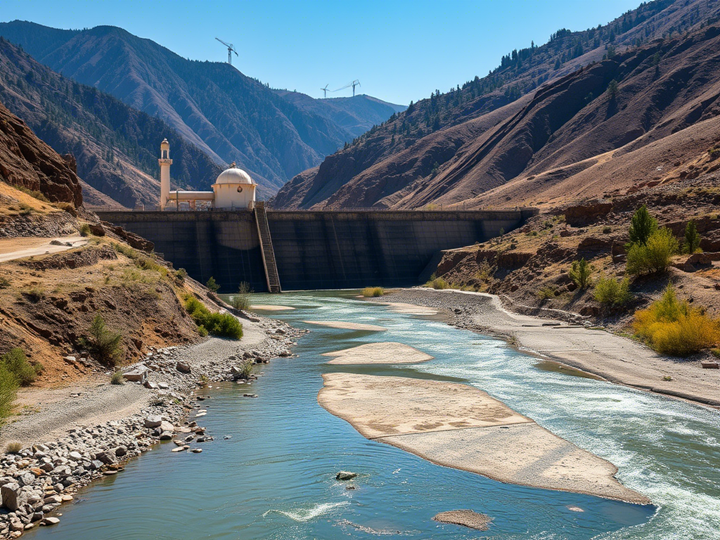Ust-Kamenogorsk HPP is switching to digital technologies
Everyone from school has a rough idea of how a hydroelectric power plant works. The dam blocks the river, creates a difference between the lower and upper reaches, the water falls under pressure, turns the turbines, kinetic energy is converted into mechanical energy, which is converted into electrical energy by the generator. It seems everything is clear, simple. And what is this scheme in real life? At the Ust-Kamenogorsk HPP, the correspondent of “Kazakhstan’s Truth” was allowed to see with his own eyes how they “make light” – they produce electricity, the main resource of the economy.

The hydroelectric power station is a feature of Ust-Kamenogorsk. And here are just some of the milestones of its history. Ust-Kamenogorsk HPP is the first–born in the famous Irtysh cascade. The main construction here was carried out at a rapid pace from 1949 to 1952. Four hydraulic units were put into operation in stages in 1952, 1953, 1959. The height of the dam is 40 meters, the installed capacity is 367.8 MW, the available capacity is 335 MW, the average annual output is 1,580 million kilowatt-hours.
Training, safety…
In the Gesovsky village of Ablaketka, they specially go for spectacular views of the dam on the Irtysh. However, the HPP itself is a strategic facility, outsiders are not allowed to enter here. They let me through only because the visit was in advance
agreed. I get an electronic pass, go through the “frame”…
– Keep it with you, – the guard warns sternly, giving the pass to the checkpoint. – There are emergency training sessions here. If you hear a siren, attach the pass to the device. The attendant will see where the guest is. Otherwise, they will start looking for you.
I put on a helmet, it is impossible to work at the industrial site without it. There’s a scheduled security meeting at the station management today. The figure shared by the General director of Ust-Kamenogorsk HPP NPP LLP and Shulbinskaya HPP NPP LLP, Tlek Aidabulov, is staggering: every year on the planet, losses from industrial accidents amount to 4% of world GDP – that’s about 6.4 trillion dollars!
In our republic, on average, 1,600 people suffer annually at work. At a hydroelectric power station, for example, risks are associated with working at height, as well as with equipment that is under voltage. By the end of 2024, the company reached an indicator of 10 thousand hours without accidents and are determined to move on without an emergency.
The main building with the engine room is several hundred meters away. The first thing that catches your eye is the almost complete absence of people on the territory. Experts like to compare the station with a living organism, and so that it does not “sneeze” or “cough”, all the staff is busy. No one has time to walk around just like that. For example, the duty shift at the main control panel lasts 12 hours. The door to this think tank is on an electronic lock, every entrance or exit is fixed. As Dmitry Baranov, the station engineer on duty, explains, if a person does not have access to the premises, he will not get there.
The remote control is striking in complexity. There are dozens of parameters on the monitors, control keys, automatic machines, and alarm boards on the shield…
– Everything is computerized, – confirms the electrician of the main control panel Rauan Tursinkhan. – Each machine is equipped with sensors, we see the processes taking place. If there are deviations, an alarm is triggered, measures are taken.
Ust-Kamenogorsk power engineers, by the way, have learned lessons from the 2009 disaster at the Sayano-Shushenskaya HPP. Each of the four units at the station today is equipped with sensors for temperature, vibration, gaps and a number of other important parameters. If sensitive equipment detects an excess, an alarm is triggered – first a warning one, then an emergency one may turn on.
The Siberians’ accident was aggravated by the lack of a backup independent power supply system. At the hydroelectric power station in Ust-Kamenogorsk, as a reserve, there is a diesel generator installed at an unheated mark. Cranes can be urgently powered from it, with the help of which, if necessary, the shields of the spillway dam can be opened.
– If necessary, each hydraulic unit can be quickly put into repair, but this does not happen here, – says Dmitry Baranov. – The main equipment undergoes maintenance every six months, as a rule, in spring and autumn. And every seven to eight years it is modernized.
The station engineer on duty and his partner electrician of the main control panel Rauan Tursinkhan explain clearly, quickly. They don’t have any extra time. Today is the launch of the third unit, which was just under current repair.
In theory, the station will immediately be able to increase capacity, but, as Rauan explains with a smile, “today I turned on one hydroelectric unit, tomorrow – all four” – so it does not work at a huge hydropower plant. The HPP has a schedule from the Irtysh Basin Inspectorate for regulating the use and protection of water resources. Only the inspectorate has the right to determine the consumption of Irtysh water allowed for generation, and for every day. And it depends only on this how many hydro turbines will be involved.
– During the day we can change the generation, – says the electrician, – but at the end of the day we must reach the permitted consumption.
In the next office – the workplace of the duty officer… across the country. A joke, of course, but in principle not so far from the truth. Daniyar Zhaysanbayev, a leading mode engineer, controls the situation on the balancing electricity market.
The fact is that since July 2023, all energy-producing entities are legally required to sell electricity to a single buyer. Each station plans and declares both its production and consumption. Deviations are unacceptable.
– And if, – I ask, – the HPP decides to produce more in order to sell more and, accordingly, earn extra money?
Daniyar shakes his head negatively: it is impossible. This will be considered a violation of the water and energy balance and will entail penalties.
– The Irtysh Basin water Inspection gives a range for a day, – the engineer explains. – The station, helping the KEGOC system operator, generates more during rush hour, and unloads the system during minimum hours. The main thing is to stay within the specified intervals for production, as well as for water consumption. This is important because in case of increased discharge, flooding downstream can be triggered. Everything is calculated. My task is constant monitoring. Ust-Kamenogorsk hydroelectric power station is a counterregulator of Bukhtarminskaya HPP in the Irtysh cascade of HPPs. If the Bukhtarminskaya station has a long–term regulatory regime, then we have a daily one.
Living history
The “heart” of the station is the engine room. The spectacle is epic. Only the upper part of the hydraulic units with turbine covers is in front of my eyes – four cars one after another. Four machines! The height of the hydraulic unit is more than 17 m, one impeller weighs 86 tons, one bolt from the turbine cover is 80 kilos! Mechanics have mega-keys weighing from 15 kg and more ready for such parts.
Electrician of the main control panel Yernar Tokpayev says: of the four machines, two are currently in operation. At the same time, the hum in the hall is such that you have to shout to hear each other. This song of turbines is written by the “voices” of water, shaft, impeller, bearings, rotor, stator…
Turbine generators are located at a lower level, impellers are even lower. Mine descents lead to them, and the staff says: “I went to the mine.” I follow Ernar down to a small observation deck. All the laws of hydropower, as they say, are present in all their glory. The water enters from a 40-meter height into the spiral chamber, is broken by the guide devices into 24 streams, rotates a huge impeller with a diameter of six meters at a speed of 83 revolutions per minute! In another room, where the rotor and stator are being monitored, the turbine is operating with such power that a strong wind is blowing. The specialist even warns: you can’t have things with you that can blow away.
Separately, there is a hydraulic unit that regulates the water flow to the impeller. Yernar respectfully strokes the device with his palm: it contains about 400 mm of turbine oil plus compressed air. Due to the powerful pressure in the pipes, the water flow entering the guide devices can be opened and closed.
– The entire cycle of power generation is controlled from a remote control, – says the specialist. – The processes of opening, closing, reducing or increasing output are fully automated. At the same time, we have the equipment to manually control the units. It’s like a reserve.
Of the four hydroelectric units installed at the HPP in the 1950s, only one – the fourth – machine has preserved its historical “filling”. Starting in 2020, three devices have undergone a complete upgrade, including replacement of the impeller, guide devices, turbine blades, etc. The capacity of each has increased from 83.3 megawatts to 95.
At the same time, according to Yernar, production begins at a capacity not lower than 55-60 megawatts. If the water inspection gave the go-ahead for a water flow sufficient for two units, the station will not work on three.
Now the next step is to upgrade the last – fourth – hydroelectric unit. He has been working for the 67th year! The project is planned for 2026-2027, and the executive power of Ust-Kamenogorsk has already supported the idea of a monument to the East Kazakhstan hydropower industry in the form of a historic 1959 impeller. A large park complex of the city can get an incredible local history “chip”.
– The modernization that the station is currently conducting is also history, – the specialist emphasizes. – In fact, today a margin of reliability is being created for the next 40-50-60 years.
By the way, for more than 70 years, the appearance of the machine room has practically not changed. Technical equipment – equipment, cables – everything has been updated and continues to be updated. But they decided not to touch the famous architectural style of the 1950s at the hydroelectric power station. Physics is physics, but they also appreciate the “lyrics” at the HPP.
Svetlana Nishchenko, a public relations specialist at the hydroelectric power station, shows the preserved amazing ball lamps and stucco in the style of the Stalinist Empire. The nameplate of the manufacturer “Leningrad Plant of the Order of Lenin, named after Stalin” is fixed on one unit.
Svetlana leads me to either a box or a capsule made of thick metal. What is it – a safe, a box for valuable equipment? It turns out that this is an individual bomb shelter.
– We can say that this is a fragment of the Cold War period, – says the specialist. – Such individual bomb shelters stood near each hydraulic unit. It was assumed that in the event of a bombing, the machinists should hide in them. There were several such structures in the hall, we left one for history…
Under control
Ust-Kamenogorsk hydropower plants still maintain close ties with the manufacturer of the main equipment – the former Leningrad Metal Plant (LMZ), today the Power Machines company. It was the St. Petersburg machine builders who manufactured new impellers with improved characteristics for the HPP.
Now contractors from St. Petersburg are helping to introduce automation to control overflows along high-voltage lines. Anton Vasiliev, a leading engineer at the electrotechnical laboratory of the HPP Management Company, shows complex modules on the monitor and explains: automation is being implemented with an algorithm for unloading the generator up to complete shutdown if the power exceeds the specified range. This is done in order to improve the reliability of power supply, plus the station will be able to apply for an increase in power output.
– Now we are setting up an automated process control system, that is, computers, sensors, – says the specialist. – Then we will “tie” relay protection and open switchgear into the system – line switches, bus systems. If previously the adjustment was done manually, now the operator will be sitting in a chair, watching. And automation – to execute.
About 500 different sensors are already monitoring the state of the HPP. The engineer for the operation of buildings and structures Gleb Shalaev agrees to show the devices that monitor the “health” of the dam. They are installed in the local “secret room of Hogwarts” – poterna.
This underground gallery is actually laid along the bottom of the Irtysh River from one bank to the other. You walk through a concrete tunnel and scroll in your head: 65 m of the dam, behind it the Ust-Kamenogorsk reservoir, overhead pressure pipelines through which water enters the units, from the edge there is a trough for the flow of filtered water…
Gleb shows the marks on the concrete wall: here the deformation seams are marked with letters and numbers. “Stitches are normal,– he assures. – They allow the structure to “walk”, relieve tension and drain water.”
The entire area is covered by an automated control system. There are sensors that record changes in cracks and temperature seams by hundredths of a millimeter. There are tilt meters that measure the slightest deviation of the dam relative to the vertical, one or two degrees. There are piezometers that determine the water level in the base of the foundation. There are sensors of tension arising in the body of concrete…
– Automation allows you to see the main parameters without leaving your office, – says the engineer. – The monitor displays data on how the seams are opened, what is the water consumption, what is the temperature. But specialists, as before, continue to take measurements manually, with a caliper and a stopwatch, on the principle of “trust, but check.”
Additional monitoring is carried out after earthquakes. So far, there has not been a single case in which deviations have been noted for some safety parameters at a hydraulic engineering facility.
…We are returning from Poterna to the territory, and I can’t resist the favorite question of all journalists: how safe is the 70-year-old dam? Gleb smiles. Somehow, experts calculated the approximate weight of the station. The total length of the Ust-Kamenogorsk hydroelectric complex is 461 m: left-bank blind dam, shield wall, right-bank dam, spillway dam, shipping lock, engine room building. Control keys, automatic machines, alarm display…
– It turned out that the weight of the structure is about 1.7 million tons, – says the engineer. – It is difficult to imagine such a force that would be able to destroy it all…
Galina Vologda (“Kazakhstanskaya Pravda”)


